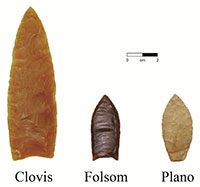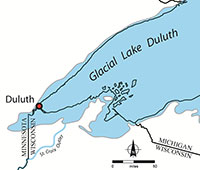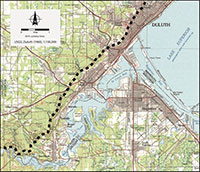First Hunters: The Paleoindian Tradition
(c. 11,200 – c. 7500 B.C.)
As the last of the glaciers retreated from northern Minnesota some 14,000 years ago, humans began to enter the Duluth area for the first time. These people, called Paleoindians by archaeologists, were highly mobile hunters and gatherers. Across the open tundra and through the spruce forests that then covered the region; they pursued herds of large game, including mastodon, bison, and woodland caribou. Paleoindians are known for the large, finely crafted lanceolate (“leaf shaped”) stone projectile points that they used as spear tips and knives. These lanceolate points are divided into two groups: those that are fluted, or grooved, (Clovis and Folsom points) and those that are non-fluted (Plano). In Minnesota, archaeological evidence for Paleoindians is generally sparse, in part because their mobile way of life did not result in dense artifact deposits like those associated with long-term occupations, and also because much of the land surface that they occupied has since been deeply buried by more recent soils. Paleoindian archaeological sites that have been found include temporary campsites, animal butchering locations, and places where stone tools were made.
During the Early Paleoindian period (11,200 to 10,500 B.C.), when Clovis and Folsom spear points were in use, downtown Duluth and much of the surrounding area was covered by the waters of Glacial Lake Duluth, which was deeper and bigger than present-day Lake Superior. Within the City of Duluth, the shoreline of this glacial lake was located about where Skyline Parkway is today. By the Late Paleoindian stage (10,500 and 7500 B.C.), the Lake Superior basin was free of ice and water levels had begun to recede. Archaeological evidence indicates that Paleoindian people lived along the shoreline of Glacial Lake Duluth and at other inland locations including the Reservoir Lakes area to the northwest of the city. Archaeological sites producing Paleoindian style projectile points have also been found in the greater Duluth area in Carlton, Cook, and St. Louis counties. These sites often contain evidence for the quarrying of stone and the production of stone tools.
Associated Images
click for larger image with caption
Copyright © 2022. All rights reserved.





